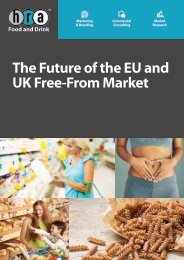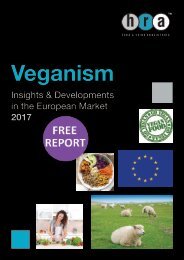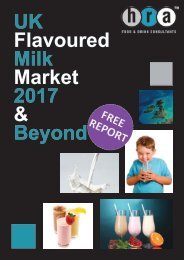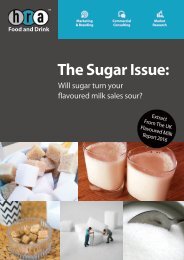FREE-UK-Flavoured-Milk-Report-2016-2017
The backdrop to the UK flavoured milk market is one of relentless change. The removal of the EU milk quotas, the transition to a Western-type diet by emerging economies, the UK sugar debate and the booming sports nutrition industry are all aspects of change that create both challenges and opportunities for the UK flavoured milk market. HRA Food and Drink Marketing has developed this report as a map to guide industry stakeholders. Although volume growth in 2014 was slightly lower than in previous years, the flavoured milk market still has plenty of room for product innovation and development. Overall, we expect the UK flavoured milk market to continue to grow over the medium term, but not without improving its nutritional profile. The sugar debate reached new heights when, in October 2015, Public Health England released a document suggesting Government intervention in the form of a sugar tax (levy). As a consequence, product reformulation has become a priority for all serious players in the market.
The backdrop to the UK flavoured milk market is one of relentless change. The removal of the EU milk quotas, the transition to a Western-type diet by emerging economies, the UK sugar debate and the booming sports nutrition industry are all aspects of change that create both challenges and
opportunities for the UK flavoured milk market.
HRA Food and Drink Marketing has developed this report as a map to guide industry stakeholders. Although volume growth in 2014 was slightly lower than in previous years, the flavoured milk market still has plenty of room for product innovation and development.
Overall, we expect the UK flavoured milk market to continue to grow over the medium term, but not without improving its nutritional profile. The sugar debate reached new heights when, in October 2015, Public Health England released a document suggesting Government intervention in the form of a sugar tax (levy). As a consequence, product reformulation has become a priority for all serious players in the market.
Create successful ePaper yourself
Turn your PDF publications into a flip-book with our unique Google optimized e-Paper software.
<strong>UK</strong>#FLAVOURED#MILK#<strong>2016</strong>217#<br />
#<br />
To Gain Access<br />
Purchase The Full<br />
<strong>Report</strong> Now<br />
Figure 6-23 Top 10 Destinations for <strong>UK</strong> Dairy Exports in 2015. Source:<br />
HMRC<br />
Arguments for Staying<br />
Arguments for Leaving<br />
Free movement of goods means the<br />
elimination of tariffs, border controls and<br />
established rules mean ease of trade<br />
between member states. With the EU the<br />
destination for 73% of the <strong>UK</strong>’s agri-food<br />
exports, minimal administrative burden is<br />
very helpful.<br />
The CAP provides support for farmers<br />
through helping them through periods of<br />
market # volatility where returns cannot be<br />
made from the market. Defra figures show<br />
55% of <strong>UK</strong> farming income comes from<br />
CAP support payments.<br />
The <strong>UK</strong> is entitled to a rebate which<br />
amounts to 66% of the difference between<br />
what it pays into the budget and what it<br />
gets back.<br />
To Gain Access<br />
Purchase The Full<br />
<strong>Report</strong> Now<br />
EU regulations can lead to high<br />
requirements for environmental<br />
legislation, labour rights and some animal<br />
welfare requirements. These requirements<br />
cannot be enforced on imported products<br />
so can lead to reduced EU global<br />
competitiveness.<br />
Switzerland and Norway’s versions of the<br />
CAP provide more support for farmers<br />
than the EU CAP does. Leaving could<br />
allow the <strong>UK</strong> to offer better support<br />
farmers.<br />
The <strong>UK</strong> pays in more money than it<br />
directly receives from the EU. In 2014 it<br />
contributed a net of £9.8bn, around 1.5%<br />
of total <strong>UK</strong> public expenditure.<br />
States in the EEA have to comply with EU<br />
environmental, food safety and veterinary<br />
legislation anyway to have the right to<br />
trade with the EU. Despite not being a<br />
member, Norway still contributes £106 per<br />
person to the EU compared to £153 by the<br />
If the <strong>UK</strong> were to contribute to the EU<br />
budget in a similar way to Norway, HM<br />
Treasury estimates <strong>UK</strong> contribution<br />
would fall by 30%.<br />
© <strong>2016</strong> Teepee Limited. All Rights Reserved.<br />
166







